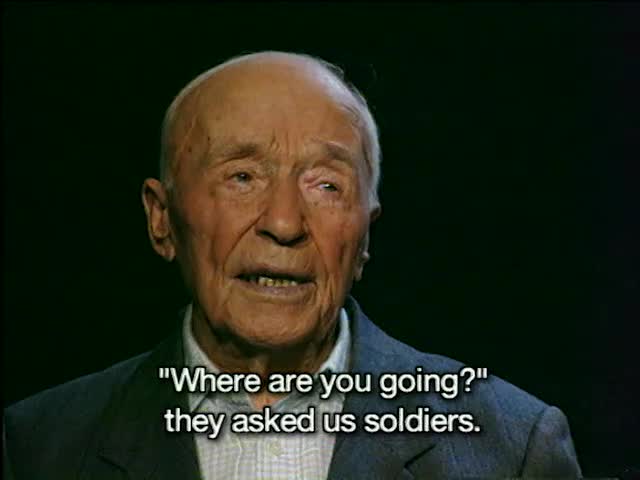SOSKA FRONTA = FIGHT FOR THE RIVER: The Story of the Italian Front 1915 - 1918

This video is not available to view remotely
Full length video - onsite only
Please read Understanding catalogue records for help interpreting this information and Using footage for more information about accessing this film.
Title: SOSKA FRONTA = FIGHT FOR THE RIVER: The Story of the Italian Front 1915 - 1918
Reference number: 6903
Date: 1996
Sponsor: TV Slovenia
Production company: AMICOM Ljubljana in association with Edinburgh Film and Video Productions for TV Slovenia
Sound: sound
Colour: bwcol
Fiction: non-fiction
Running time: 48.00 mins
Description:
'In WW1 a million casualties were inflicted on this 200 mile front, ranging from the Mediterranean summer heat to the Arctic cold of the Alpine peaks, which made this one of the bloodiest battlefields of the world. It was fought over the river Isonzo which became synonymous with massacre, fear and despair for the soldiers of 13 nations. The never before seen footage in this video was suppressed by both the Italian and Yugoslav governments to protect their version of history. Only now can the story be told of this Italian disaster, with Serbs fighting on the Allied side against all other Yugoslav peoples.
Eleven major Italian offensives failed to break the Austro-Hungarian defenses and this is the story of massive allied failure against a background of huge undisclosed casualties. For the soldiers it was a war of endurance, artillery, mortar attack, poison gas, machine guns, avalanches and rats.
It was here that Ernest Hemingway fell in love with a hospital nurse and wrote Farewell to Arms. It was here too that both Rommel and Mussolini served their military apprenticeship.' [Information sourced from website http://www.ihffilm.com/841.html, last accessed 4/8/2004]
Credits:
historial research Prof. MAriko Simic
sc. Peter Povh
narr. Michael Williams
p. Matjaz Mihelcic, Robin Crichton
p.man. Tomaz Grubar
p.ass. Vasja Mihelcic
cam. Ales Belak
ass.cam. Aleksander Djurisic
add.ph. Izidor Faric, Samo Podobnik, Miha Tozon
ed. Iztok Suc
ass.ed. Tomo Zajc
sd.rec. Tone Zerovnik
m.dub.ed. Ivo Mesa
dub.ed. Boris Romih
graphics des. Janez Ferlan
tech.adv. Prof. Dr Anton Zabkar, Dr. Manfred Rauchensteiner, General Guiseppe Cuchiu, Lilijana Nedic, Zeljko Cimpric
archives Jugoslavia kinoteka Beograd; The Imperial War Museum of Great Britain; TV Slovenia; Kobariski muzej, Kobarid; Goriski Musej, Nova Gorica; NUK Ljubljana; Private collections
archive m. RTV Slovenia
The producers gratefully acknowledge the assistance of The Republic of Slovenia Ministry of Defence; The Slovenia Air Force; The Slovene Film Museum; HIT, Nova Gorica; Hoteli Alkomeric, Tolmin d.d.
Shotlist:
[00:01:00:001] colour documentary film narrated in English featuring a comprehensive amount of black and white archive footage and interview with former Austro-Hungarian soldier Anton Kovacic born 1898 (subtitled). Changing troop positions illustrated with computer graphics of map of Europe. It ends with the collapse of the Austro-Hungarian Empire [00:49:00:05]
'In WW1 a million casualties were inflicted on this 200 mile front, ranging from the Mediterranean summer heat to the Arctic cold of the Alpine peaks, which made this one of the bloodiest battlefields of the world. It was fought over the river Isonzo which became synonymous with massacre, fear and despair for the soldiers of 13 nations. The never before seen footage in this video was suppressed by both the Italian and Yugoslav governments to protect their version of history. Only now can the story be told of this Italian disaster, with Serbs fighting on the Allied side against all other Yugoslav peoples.
Eleven major Italian offensives failed to break the Austro-Hungarian defenses and this is the story of massive allied failure against a background of huge undisclosed casualties. For the soldiers it was a war of endurance, artillery, mortar attack, poison gas, machine guns, avalanches and rats.
It was here that Ernest Hemingway fell in love with a hospital nurse and wrote Farewell to Arms. It was here too that both Rommel and Mussolini served their military apprenticeship.'
[Information sourced from website http://www.ihffilm.com/841.html, last accessed 4/8/2004]






